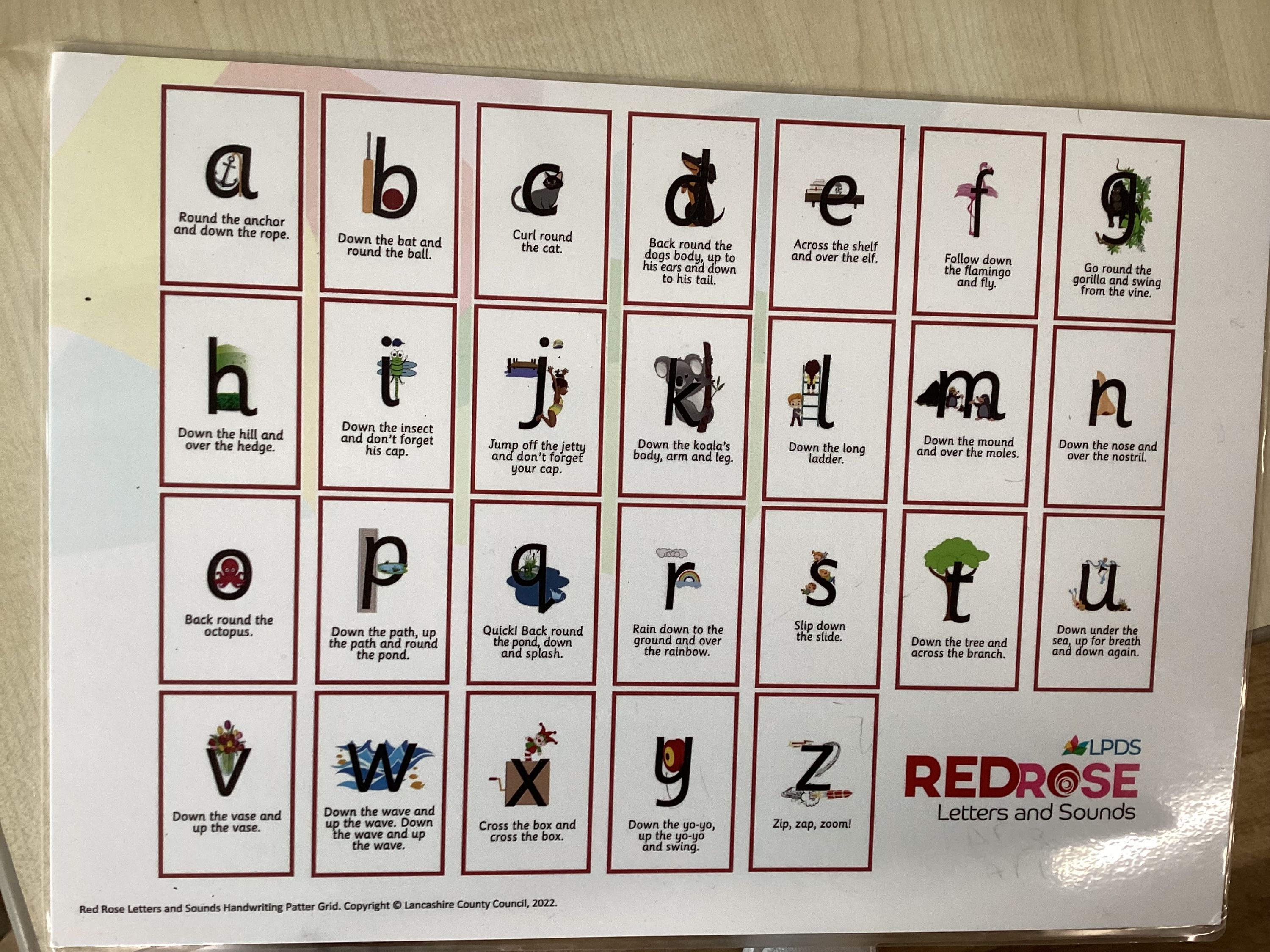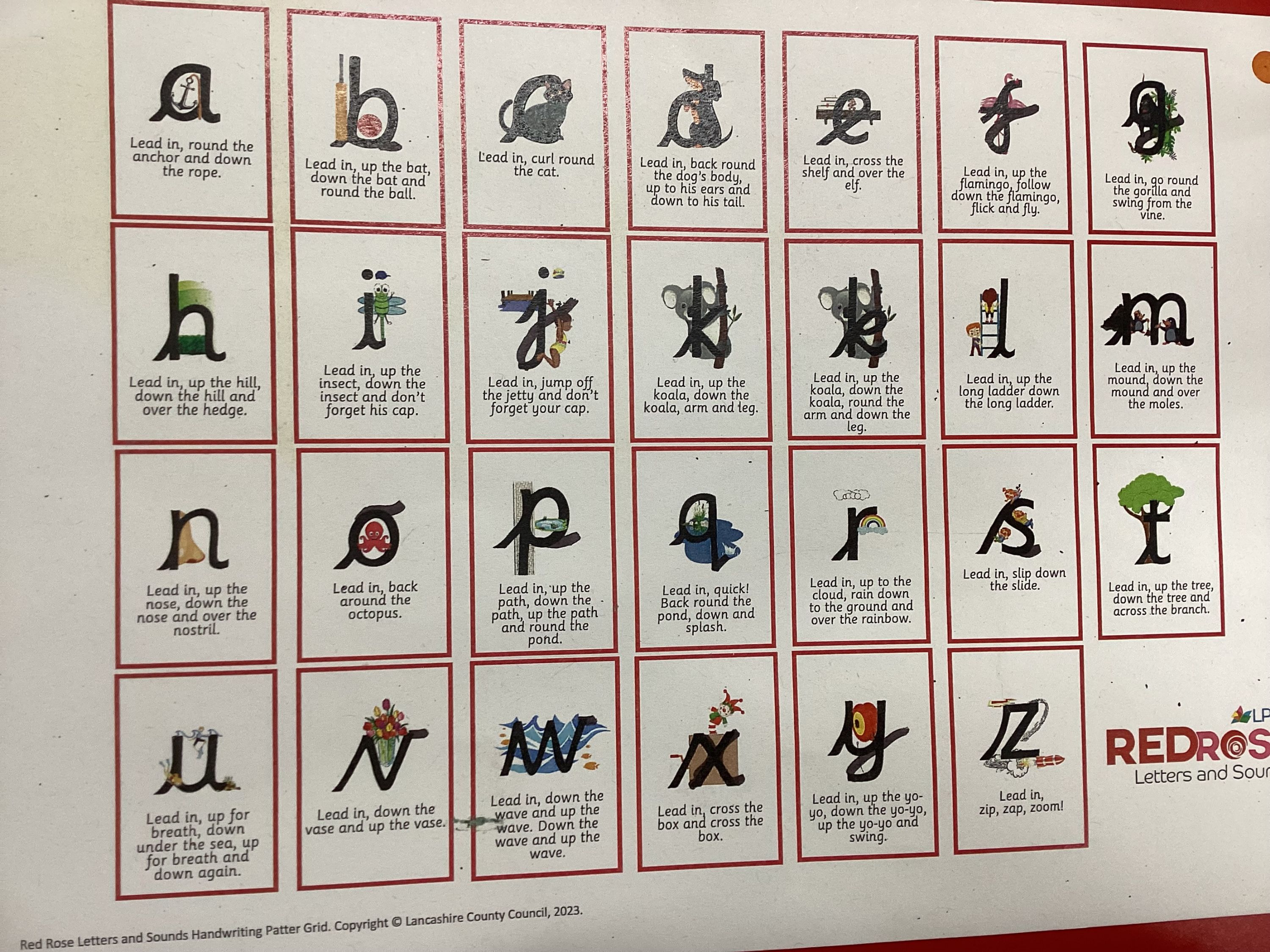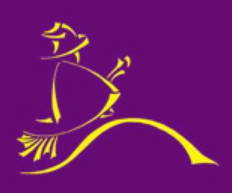English
English at Pendle
Subject Leader: Kate Markham
At Pendle Primary School we strive for children to be a ‘Primary Literate Pupil’ and be ready for the next stage of their education and beyond.
We aim for children to :
- speak, read and write with confidence, fluency and understanding, orchestrating a range of independent strategies to self-monitor and correct.
- have an interest in books and read for enjoyment.
- have an interest in words, their meanings; developing a growing vocabulary in spoken and written forms.
- understand a range of text types and genres – be able to write in a variety of styles and forms appropriate to the situation.
- develop their powers of imagination, inventiveness and critical awareness.
- have a suitable technical vocabulary to articulate their responses.
Phonics
In EYFS and KS1 we follow the progression from ‘Red Rose Phonics’. The Red Rose Letters and Sounds Phonics programme is a systematic, synthetic phonics planning programme developed by the Lancashire Professional Development Service (LPDS). It is based on the well-established Letters and Sounds framework with comprehensive planning for phonics instructions from Phase 2 to Phase 5, with a strong focus on the Revisit/Review, Teach, Practise and Apply daily lesson structure.
Its impact includes strengthening overall literacy skills, fostering enthusiastic readers and writers as well as improving outcome or children by providing a clear framework for teaching phonics. All staff are trained to deliver the programmes consistently which ensures the children receive high-quality education.
Home Reading Books
In EYFS and Key Stage 1, the home reading books are carefully sorted according to the phonics phases taught each week. This means that as your child learns new sounds and phonics skills in class, they will receive books that match those specific phases. This approach helps to reinforce their learning by allowing them to practice reading words and sentences that use the phonics patterns they are currently studying, making reading at home both easier and more effective.
We use a variety of reading schemes to teach reading such as: Dandelion Launchers, Reading Stars Phonics, Word Sparks, Floppy's Phonics, Oxford Reading Tree Phonics, Oxford Reading Tree Phonics Traditional Tales, Songbirds and Collins Big Cat Phonics.
In Key Stage 2, the home reading books are colour coded to match the children's ability.
Guided Reading
Key Stage 1
Each day, the children take part in guided reading sessions where they work in small groups either with an adult or working independently on a specific reading task. During these sessions, they focus on developing key reading skills, including fluency (reading with accuracy, expression, and pace) and comprehension (understanding what they read). These sessions are tailored to their reading level and help build confidence, vocabulary and a deeper understanding of texts.
Key Stage 2
In Key Stage 2 the children take part in whole class guided reading sessions each day. These sessions enable the children to access the same high-quality text, regardless of their individual reading level. This approach has several key benefits:
- Improved vocabulary and comprehension: Sharing a rich text as a class allows children to encounter and explore new vocabulary and ideas together, with plenty of opportunities for discussion and deeper understanding.
- Equality of access: All children are exposed to challenging texts, not just those who are fluent readers. With the teacher’s support, every child can engage with ambitious language and concepts.
- Shared learning experience: Whole-class reading encourages meaningful discussion, peer learning, and a collaborative approach to understanding texts. Children benefit from hearing others' thoughts and interpretations.
- Focus on key reading skills: Teachers can explicitly teach skills such as inference, summarising, prediction and analysis, helping all children become confident, thoughtful readers.
- Efficiency: Teachers can model fluent reading and guide all students at the same time, ensuring consistent teaching of comprehension strategies across the class.
Reading school
We are a reading school where we actively celebrate a love of books. We encourage children to discuss and share what they have been reading, this is enhanced by all adults in school sharing and promoting their love of reading. We celebrate World Book day, which is always a highlight in the school year, children talk enthusiastically about coming to school either dressed as their favourite character, a word or coming to school in their pyjamas for a bedtime stories theme to World Book Day.
Our library provides opportunities for children to widen their reading horizons and is a reading hub for our school.
In each classroom the children have access to a range of books which are designed to encourage a love of books and reading for pleasure. The children are able to enjoy the age-appropriate books during independent reading time or quiet moments.
In addition to storybooks and familiar favourites, we also provide a range of topic books linked to the current subjects being taught in class. These help children explore and deepen their understanding of key curriculum areas, such as science, history or geography, through engaging and informative texts.
Writing
We develop writing skills including grammar, punctuation and spelling, so that our children have the skills, knowledge and stamina to write, in range of genres and for different purposes, at an age appropriate standard. The teaching of writing is systematic, consistently built on prior learning and incorporating shared, modelled, guided, edited and independent writing.
SPaG
Children are explicitly taught SPaG skills (Spelling, Punctuation, and Grammar) as part of their daily English lessons. This means that specific rules and concepts are introduced clearly and directly, using structured teaching methods.
Lessons focus on building a strong understanding of how language works, helping children to:
- Use punctuation accurately (e.g. full stops, commas, speech marks),
- Apply correct grammar (e.g. verb tenses, sentence structure),
- Spell words correctly using phonics patterns and spelling rules.
These skills are then revisited and reinforced regularly through writing activities, so children can confidently apply them in their independent work.
Spelling
In EYFS and Key Stage 1, spelling is taught primarily through phonics. Children learn to read and spell by breaking words down into individual phonemes (sounds) and blending them together. As they are introduced to new sounds each week, they also learn how to use these sounds to build and spell words.
Alongside phonics, children are also taught to read and spell 'tricky words'—these are common words that cannot be sounded out easily (like said, was or the). Because these words don’t always follow regular spelling rules, children learn to recognise and remember them by sight.
This combined approach helps children become confident, fluent readers and writers from an early stage.
To support home learning, the weekly phonics phonemes and tricky words are shared with parents and carers, so children can practise at home and reinforce what they’ve learned in school.
From Year 2 to Year 6, children are taught spellings daily using the Rising Stars Spelling scheme. This structured programme helps children learn key spelling rules, patterns and strategies in a progressive way, building their confidence and accuracy over time.
Each week, children focus on a specific spelling pattern or rule and take part in engaging activities that help them understand how and when to apply it in their writing. These lessons also include revision of previous learning to ensure skills are retained.
To support home learning, the weekly spellings are shared with parents and carers, so children can practise at home and reinforce what they’ve learned in school.
Handwriting
Handwriting is explicitly taught, meaning that children are given clear, direct instruction on how to form letters correctly. This includes guidance on:
- Where to start each letter,
- The direction and order of the strokes,
- The correct size and spacing of letters,
- How to sit properly and hold a pencil comfortably.
Teachers model the handwriting step-by-step, and children practise regularly with focused activities to build muscle memory and control. This careful teaching helps children develop neat, legible handwriting that becomes automatic over time.
Non-cursive handwriting is introduced in EYFS and then the children learn cursive handwriting from Year 1. Children are very proud to progress from pencil to pen once they have a fluent joined handwriting in key stage one and two.
English within EYFS
English in EYFS is guided by the requirements and recommendations set out in the Early Years Foundation Stage Statutory Framework for the EYFS (2025) and with guidance from Development Matters and Birth to 5 Matters.
Literacy ELG:
Comprehension - Children at the expected level of development will:
• Demonstrate understanding of what has been read to them by retelling stories and narratives using their own words and recently introduced vocabulary.
• Anticipate – where appropriate – key events in stories.
• Use and understand recently introduced vocabulary during discussions about stories, non-fiction, rhymes and poems and during role-play.
ELG Word Reading - Children at the expected level of development will:
• Say a sound for each letter in the alphabet and at least 10 digraphs.
• Read words consistent with their phonic knowledge by sound-blending.
• Read aloud simple sentences and books that are consistent with their phonic knowledge, including some common exception words.
ELG: Writing - Children at the expected level of development will:
• Write recognisable letters, most of which are correctly formed.
• Spell words by identifying sounds in them and representing the sounds with a letter or letters.
• Write simple phrases and sentences that can be read by others.
Reading is at the heart of the Pendle curriculum
 Handwriting progression:
Handwriting progression: 

